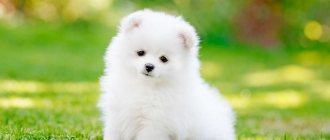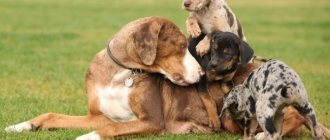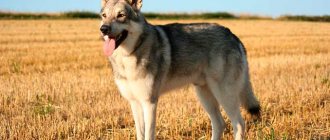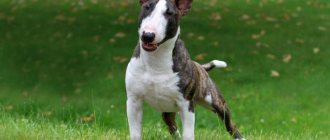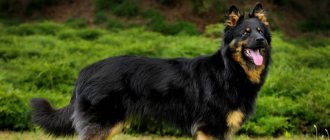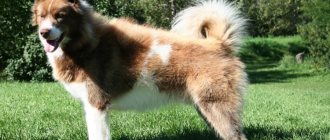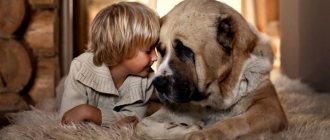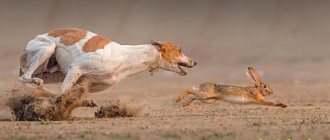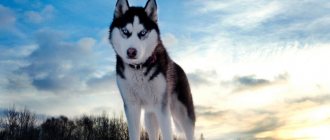Many people note the amazing similarity between a wolf and a dog, despite the fact that they have different habitats: the former live in the wild (at least in a zoo), the latter live next to humans. But this may seem so only to those who do not know how to distinguish a wolf from a dog, since these animals actually have quite a lot of differences and all of them are very significant.
Common features
The wolf and the dog belong to the family of mammals that feed their offspring with milk and have a number of other common characteristics:
- They are natural predators, regardless of what owners feed their pets.
- They have a similar appearance (applies to some breeds of pets).
- They are sociable animals if they are in their environment.
- They are capable of making similar sounds (howl, growl, bark) due to the similar structure of the vocal cords, but they use them in completely different situations.
But despite some common features, these animals have many differences.
Animal differences
First of all, it is worth noting the obvious difference: the wolf is a wild animal, and the dog is domesticated by man, which is distinguished by the diversity of species and significant differences in appearance, which sometimes make them completely different from representatives of the same canine family. But even those breeds that really look like their wild relatives have a number of characteristic features, knowing which you can easily distinguish one animal from another.
The differences between a wolf and a dog are manifested in the following parameters:
- Dimensions. As a rule, wolves are larger in size. Their average weight ranges from 34-55 kg, but sometimes males can gain up to 80 kg of mass.
- Head shape and muzzle. The wolf's head is shaped like the head of the German Shepherd breed, but it is more massive and has a more elongated and pointed muzzle.
- Ears. Wolves are simply not able to press them to their heads, so they always keep them raised. The ears are usually small in size relative to other parts of the body and are overgrown with hair on both the outer and inner surfaces.
- Tail. In wild predators, the tail never curls, is held horizontally to the ground or lowered down and always remains practically motionless. Only pets are characterized by wagging their tail to express emotions.
- Jaws. Representatives of wolves have a fairly narrow jaw, which is characterized by greater strength.
- Eating. Wild predators always eat very slowly because they may choke.
On a note! The characteristic groans and whines during a meal are associated precisely with the rapid swallowing of food, as a result of which wolves experience pain.
- Movement style. The wild predator moves at a trot, and its hind legs are placed exactly in the already imprinted tracks of the forelimbs. When moving in groups, they follow each other in the tracks of the first animal in the pack, which makes it easier to move long distances.
- Movement speed. Although predators can stalk prey for days, they cannot sustain high-speed pursuit over long distances (more than 300 m).
- Attitude towards prey. During a hunt or fight, a dog immediately bites the victim to death, while a wolf seems to cut it into pieces, which is due to the anatomical features of the structure of the jaws.
Who is stronger, wolf or dog?
The debate about who is stronger, a wolf or a dog, has not subsided for a very long time. Some say that wolves (the majority), some argue that a dog of the so-called “wolfhound” class will easily win. It is worth noting that an exact answer cannot be given, since all results depend on the conditions of the fight, the condition of the animals, etc. But a superficial analysis will reveal a clear leader.
Wolves
In nature, wolves are real hunters. They constantly hunt and kill. They are patient because they live a life full of various dangers. These include bears, a collision with which will not lead to anything good, and poachers, and nature itself (rains, frosts, fires). Therefore, every living wolf is no longer a defenseless animal. Wolves do not eat carrion. Therefore, they need to constantly hunt. At one time, the average representative of this class can eat about 10 kilograms of meat.
Dogs that can compete with a wolf
It is incorrect to say “is a dog stronger than a wolf”. Firstly, there are different wolves (Mackensian, red, etc.), and also, there are different breeds of dogs. In general, medium and small representatives should be weeded out immediately, since they, most likely, will not even be able to seriously injure the wolf.
Therefore, only fighting dogs and wolfhounds remain. Wolfhounds have long been used to protect flocks of sheep and other domestic animals. There are many legends about them, which seem to be reality, given the massive body and large jaws of representatives of this type. In most cases, when a wolf attacked a herd, they died. But there is one huge nuance. In general, most often, several wolfhounds are used to guard the herd at once. This makes the fight between the dogs and the wolf unequal.
Fighting dogs are real warriors who are seasoned by battles in the arena. Their sensitivity is dulled, they are not afraid of a fight.
And in history there are indeed several practical cases where they met in battle in the battle arena with wild wolves. Now let's look at the top 6 dogs that can still kill a wolf.
American Bulldog
Let's not say that this is the strongest dog in the world. But the American Bulldog has one peculiarity. He has a very good grip. If we compare the grip of a wolf and a dog, then the “wild” one clearly loses in this indicator. The average weight of a bulldog is 40 kg. Naturally, if he meets an alpha male, the outcome for the pet will be disastrous. But, in an equal weight category, this breed can compete well with any type of wolf.
Caucasian Shepherd Dog
Representatives of this breed are very loved in Russia. On average, the weight of an adult is 40-80 kg. Height 60-75 cm. This is a massive breed that can really defeat a wolf. The Caucasian Shepherd is very aggressive towards strangers and is capable of fighting back. It is worth noting that this breed is not shy. In a battle with a wolf, he is unlikely to be able to overwhelm her. However, the “wild” one will have a greater percentage of victory due to its tooth structure. Wolves have more penetrating and sharp teeth that can deliver deadly bites. The Caucasian Shepherd, like other dogs, does not have such teeth.
Irish Wolfhound
These are huge dogs that can give a wolf a hard time. Despite the fact that the pet has a very calm and friendly character, in a fight with a wolf they will not show fear and will resolutely accept the fight. Since ancient times, they have been used to protect herds of sheep and other living creatures. Now they are pets. Naturally, a domestic Irishman is unlikely to be able to withstand a wolf, but if it is a well-trained pet, then it is likely that he will be able to win.
Buryat-Mongolian wolfhound
This breed has long been used to guard herds. Nowadays they are used as guard dogs, bodyguards and detection dogs. The average weight of a pet is 50-70 kg. Since ancient times, this breed has been used for hunting wolves, wild boars, and smaller animals. Overall, they can really cause a lot of problems for a wild wolf.
Tibetan mastiff
Perhaps these representatives can provide the greatest competition to the wolf. This is an ancient breed that long ago served in Tibetan monasteries as a guard. The average weight of a pet is 60-80 kg. The breed has a very soft character; it never resists the orders of its owner. But, in the event of a fight, she will be ready to fight to the last.
Central Asian Shepherd Dog (Alabai)
This dog seems clumsy and clumsy. But at 80kg it really is a killing machine. The breed has a soft and calm character, but when in danger they simply “explode”. During exhibition battles, it was revealed that Alabais are active only in the first minutes of the battle. Afterwards, they simply try to leave, because they either get tired or lose interest in the process.
All the breeds described above are dogs that can defeat a wolf, and not those that are 100% likely to win. To a greater extent, we can say with confidence that the battle of any of them will end in defeat. Still, the wolf is a predator, it has sharper teeth and lacks fear.
Source
Distinctive features of the tracks
The differences between the tracks of a wolf and a dog are clearly visible on soft soil and especially fresh snow. At first glance, the tracks of a wolf's paws resemble those of a large breed pet, so it is difficult for an untrained person to determine whether they belong to a particular animal. But upon closer examination, one can identify characteristic signs of wolf tracks by which these animals can be distinguished:
- Greater elongation compared to dog prints.
- Greater depth and clarity of claw and fingerprint prints, which is associated not only with greater mass, but also with stiffer paws and large claws. A dog’s finger pads are more tightly packed (forming a kind of lump), so they leave less distinct marks.
- The prints left by the paws during movement are located almost in a straight line (forming a line) and the higher the speed of movement, the straighter it is, while dog tracks are always more tortuous.
- The prints of the two middle toes of a wolf's paw are shifted slightly back relative to the outer toes, so a twig or an imaginary line drawn between them will not overlap either one or the other. Whereas on a dog track it will partially intersect them, which can be seen in the photo below.
What are the differences?
After we have looked at how to distinguish a wolf from a dog, let’s figure out what causes these differences. All of them are associated with two groups of factors:
- Natural, conditioned by life next to humans, which made it possible to tame animals and change their behavior, while wild predators are still subject to natural reflexes and behavior patterns, without which it would be difficult for them to survive in the wild.
- Artificial, associated with selection, as a result of which changes in the appearance of animals appeared.
It was domestication and living together with humans for thousands of years that became the basis of the differences that can be traced today between the wolf and the dog. After all, once upon a time they were completely absent. Wolves remain active at night, while domestic pets have managed to adapt to the rhythm of human life: they most often rest at night and are awake during the day. At the same time, domestic animals rarely howl, while their wild relatives do not bark in their natural habitat, but if they fall into captivity, the latter are able to adapt to a new environment and use barking as a means of communication.
Examples[edit]
Religion, mythology, folklore[edit]
- Zoroastrian hymn to the dog from the appendices to the Avesta:
| « | Her voice awakens, and no evil creeps up in secret - wolves are killed, wolves are torn, wolves are thrown back, wolves spit saliva from frustration. | » |
Literature[edit]
- I. A. Krylov, “Wolf in the kennel.”
- R. Kipling, “The Jungle Book”: red dogs here are not servants of people, and dogs are only in name (this is a completely different species - red wolves); however, for wolves they are more dangerous enemies than Shere Khan (at least you can talk to them). In “The Ballad of East and West” he has a rather offensive metaphorical contrast:
| « | “Well, if you don’t care about the price, but your brothers are in demand for food - The jackal and the dog are the same offspring - call the jackals, dog.” <…> Kamal grabbed him with his hand and looked straight at him. “Not a word about dogs,” he said, “there’s a dispute between wolves and wolves.” | » |
| - Dogs are bad, wolves are good | ||
- E. Seton-Thompson - in several stories at once. The author’s position is clear and obvious - one on one, any dog, regardless of its height, strength and weight, does not have a single chance against a seasoned wolf. And God grant that she takes the fight at all. The wolf easily copes with two healthy Great Danes (one of the ancestors of the modern Great Dane), instantly deals with a feisty American bulldog (this dog weighs much more than an English one - up to 60 kg) and kills a brave bull terrier. Moreover, until the last one rushed into battle, the entire pack - almost a dozen huge and ferocious dogs, which had previously fearlessly driven the wolf, did not dare to attack the ominous predator. At the same time, Seton-Thompson treats wolves and dogs with equal sympathy; he has stories about both heroic wolves and heroic dogs.
- JRRT, The Silmarillion, especially the story of Beren and Lúthien: the wolves are the servants of Morgoth, and on the side of the heroes is the Valinor dog Huan.
- S. Mikhalkov, fable “Polkan and Shavka”. Two dogs came across a pack of wolves, which here symbolized Hitler’s invaders (“Adolf” translates as “noble wolf”, and Hitler was generally a fan of gray predators). The brave Polkan rushed into battle and killed one wolf, but the rest finished him off on the spot. The mongrel humiliatedly asked the grays for mercy, promising in return to lead them to a whole herd of cows. I didn’t deceive you, I brought you. True, for some reason she did not say that the herd was very seriously guarded (didn’t know? forgot? did she keep silent on purpose, luring predators into a trap?). However, before attacking the herd, the wolves tore to pieces this “also a dog”: what if he comes to his senses and leads people? And in general, this Shavka is superfluous, from the point of view of the wolves. But this murder did not help them: the shepherds with guns destroyed the entire flock. So, in the end, it turned out that Polkan’s heroic death was less useful than Shavka’s cowardice. It seems that Mikhalkov later realized that his fairy tale had a double bottom. In the animated film adaptation filmed under his wise leadership, the bug was fixed, reducing the pack to just two wolves (from which Shavka already had a chance, if not to fight off, then to escape), and the guards to one shepherd.
- And also dogs on the coat of arms of the Clegane knights serving the Lannisters. Sandor Clegane first meets Arya Stark as an assassin and a thug, and Arya hates him... but later, being forced to travel together, they somehow got used to each other. Sandor himself justifies this approximately like this: “I am now a wild dog, and this is the same wolf.” Well, there’s no mention of older brother Gregor.
- In the thoughts of the protagonist and the author's text, the trope occurs often and without any wick - as a metaphor. It is also often used in poems inserted into the text, as a plot element or, again, as a metaphor.
?” On the other hand, all werewolves once received their strength from the Winged Dog - the god Simargl, and still have serious respect for him.
Cartoons[edit]
- “Once upon a time there was a dog” - zigzag. On the one hand, the main characters become at least good friends; on the other hand, they used to be at enmity, but “in public” they still pretend to be at enmity.
- A comic version in the cartoon by T. Avery “The Three Little Pups” (“Three Puppies”, 1953). The tale of the three little pigs, only the piglets have been replaced by puppies (“Droopy multiplied into three copies”), and the Wolf is not going to eat them because he works for a dog catching service. And also other cartoons about the confrontation/rivalry between a wolf (usually McWolf) and Droopy.
Anime and manga[edit]
- “Wolf’s Rain”: either a wick, or a complete zigzag. Calling a wolf a dog is a grave insult; however, they communicate quite friendly with real dogs. And Blue is a half-breed. On the other hand, they communicate friendly with the hunting dogs of the Indians. And small indoor mongrels, at one glance at a wolf passing by, whine with their tail between their legs.
Board games[edit]
- The ancient Egyptian game “Dogs and Jackals” - with a screwed-on wick, since jackals are not wolves after all.
Music[edit]
In modern songwriting, one predominantly encounters an option with the author’s sympathy on the side of the wolves:
- Vladimir Vysotsky, “Hunting from Helicopters” aka “The End of the Wolf Hunt”: see epigraph.
- Diana Arbenina “Hunting for wolf cubs”
- Maxim Leonidov, “Wolves”: here the lyrical hero, although a dog, has gone over to the side of the wolves and “declared war” on his former relatives:
| « | I was once a dog, and I don’t look too much like a wolf, But I broke the dog law, and now I’m screwed. The cloudy light of the clouds, the evil sun has risen over the forest, And now I am among the wolves, I am one of the pack. | » |
- Alexander Rosenbaum, “Will”. Here the dog only dreams of running away to the wolves, but the contrast between the wolf and dog lifestyles is obvious.
- Ivan Kuchin, “Man in a Padded Jacket.” The fugitive convict compares himself to a wolf he met in the forest; the guards' dogs are hostile to them.
- 25/17, "Teen Wolf". About a boy from a dysfunctional family who became a soldier in the Chechen war. “The wolf cub will grow up to be a wolf and will tear dogs apart”
(by the way, the Chechens themselves have a “totemic” animal - just the wolf). - “Wolves” by the Chechen rocker Bekhan to the lyrics of Vladimir Soloukhin: “So be afraid, bitches, when we go hunting. There are strong hands, we hate you miserable dogs.” The author himself said that he initially heard it as a yard song in his native Grozny.
- Dan Nazgul, “Wolf Rock”: “But please consider one fact: I’m not a dog, I’m a wolf!”
- Nikola Emelin “The Gray Song”: “It’s better to be a free wolf and howl at the moon, / Than to sit, crawl, lie and lick the owner...”
- Vitaly Aksenov, “Wolf Sun”. The contemptuous attitude of wolves towards their “relatives” is obvious.
- Slava Bobkov, “Bracelets”.
